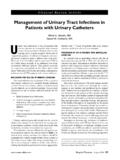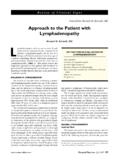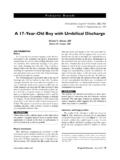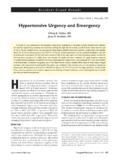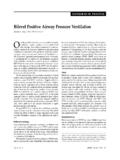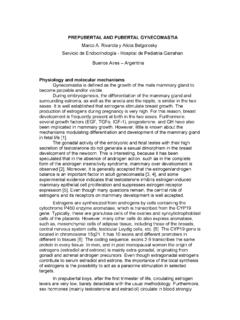Transcription of Signs of Hyperandrogenism in Women - Hospital …
1 Hospital Physician October 2008 25 Hyperandrogenism is characterized by excess production of androgens by the ovaries and/or the adrenal glands. The most common clinical manifestation of Hyperandrogenism in Women is hirsutism, excessive terminal hair growth in androgen-dependent areas of the Other clini-cal manifestations of Hyperandrogenism include acne vulgaris, weight gain, menstrual irregularities, and, in some Women with polycystic ovary syndrome (PCOS), acanthosis nigricans. The underlying cause of androgen excess can often be identified with a thorough history and physical examination, including age of onset, dura-tion and severity of symptoms, and examination of the skin, breasts, pelvis, and abdomen. Specific laboratory studies (eg, serum total and free testosterone, dehydro-epiandrosterone sulfate [DHEA-S]) can be performed if the history and physical examination cannot pinpoint the cause. Most causes of Hyperandrogenism are be-nign, although rapid onset or progressive worsening of symptoms suggests malignancy.
2 This article describes the manifestations of Hyperandrogenism in Women and outlines the possible underlying causes of androgen ex-cess. Treatment is also briefly discussed. EVALUATION OF HYPERANDROGENISMM anifestations of androgen excess are typically evi-dent with a detailed history and physical examination. The history should emphasize age of onset, timing of onset (gradual or rapid), and duration of symptoms, and menstrual history should be elicited to determine irregularities. Physical examination should include inspection of the skin, breasts, pelvis, and abdomen. Hirsutism, excessive terminal (coarse) hair growth in androgen-dependent areas of the body, is the most common sign of Hyperandrogenism , occurring in 60% to 80% of Hirsutism should not be confused with hypertrichosis, which is defined as a diffuse in-crease in vellus (fine) hair growth. Virilization, defined as the development of male characteristics in Women , that is of rapid onset is generally a more ominous sign, suggesting the presence of an androgen-secreting ovar-ian or adrenal estimated 5% to 10% of Women in the general population are ,4 However, prevalence rates of hirsutism depend somewhat on the scoring method used to determine its The most commonly cited scoring system for hirsutism is the Ferriman-Gallwey scale first proposed in Hatch and colleagues7 modified this scoring system to include 9 androgen-sensitive areas of the body.
3 Each area is scored from 0 to 4 depending on the amount of terminal hair growth (Figure 1). A score of 8 or greater indicates the presence of hirsutism, although some experts recommend a score of 6 or ,8 As with any subjective scoring system, interobserver agreement It is important to note that the sever-ity of hirsutism does not correlate well with the level of androgen and may vary in different ethnic For example, hirsutism is less prevalent among Women of Asian is a common manifestation of Acne is characterized by increased sebum pro-duction, follicular epidermal hyperproliferation, prolif-eration of Propionibacterium acnes, and inflammation and occurs predominantly on the face and to a lesser R e v i e w o f C l i n i c a l S i g n sSeries Editor: Bernard M. Karnath, MDSigns of Hyperandrogenism in WomenBernard M. Karnath, MDCAUSES OF Hyperandrogenism Polycystic ovary syndrome Idiopathic hirsutism Hyperandrogenic insulin-resistant acanthosis nigri-cans (HAIRAN) syndrome Congenital adrenal hyperplasia (classic and non-classic) Cushing s syndrome Androgen-secreting tumors (ovarian, adrenal) Hyperprolactinemia Hypothyroidism Androgenic medications (eg, danazol)Dr.
4 Karnath is an associate professor of medicine, University of Texas Medical Branch at Galveston, Galveston, TX. K a r n a t h : H y p e r a n d r o g e n i s m : p p . 2 5 3 026 Hospital Physician October 2008 on the back and chest. Like hirsutism, the sever-ity of acne does not correlate well with androgen levels. Androgens play a key role in the development of adult-onset acne. Measurement of circulating androgens in patients presenting with adult-onset acne and hirsutism is helpful for finding the underlying ,12 Acanthosis nigricans is characterized by areas of hy-perpigmented, velvety plaques typically found in the ax-illa, neck, and groin areas and is found in patients with PCOS or type 2 diabetes Its presence should prompt an evaluation for impaired glucose EVALUATIONT estosterone is the key circulating androgen; it is secreted directly from the adrenal glands and ovaries or produced through metabolism of androstenedione or DHEA-S in peripheral ,7,13 In the setting of rapid onset of hirsutism or virilization (eg, acne, deepening of the voice, frontal balding, increased muscle mass), laboratory evaluation should include measurement of testosterone and DHEA-S.
5 The normal testosterone level in Women is less than 100 ng/dL. Free testosterone binds to tissue receptors, and measurement of free testosterone is 50% more sensitive for detecting androgen excess than total However, free testosterone assays can be difficult to obtain because an accurate measurement requires a dialysis procedure. The calculated free andro-gen index (FAI; total testosterone level divided by sex hormone binding globulin [SHBG] level) can be used to estimate free testosterone and is a sensitive marker for detecting androgen A ratio of less than 7 on the FAI is considered normal in Women . Very high levels of total testosterone (> 200 ng/dL) or DHEA-S (> 700 g/dL) can suggest an underlying neoplasm, but not all patients with these values will have a tumor. As mentioned previously, the severity of hirsutism also does not correlate well with the level of Laboratory abnormalities and additional findings associated with disorders that cause hyperan-drogenism are outlined in the OF HYPERANDROGENISMP olycystic Ovary SyndromeFirst described in 1935 by Stein and Leventhal,15 PCOS is the most common endocrine disorder in Women of childbearing age, affecting 5% to 10% of Women in this ,16 19 PCOS usually begins at puberty, and manifestations of PCOS include hirsut-ism, obesity, insulin resistance, acanthosis nigricans, and menstrual 1.
6 The Ferriman-Gallwey scoring system for hirsutism. (Reprinted from Hatch R, Rosenfield RL, Kim MH, Tredway D. Hirsutism: implications, etiology, and management. Am J Obstet Gynecol 1981;140:815. Copyright 1981, with permission from Elsevier.) Hospital Physician October 2008 27K a r n a t h : H y p e r a n d r o g e n i s m : p p . 2 5 3 0 PCOS is commonly associated with insulin resistance and hyperinsulinemia. Insulin stimulates secretion of androgens by ovarian theca cells and also inhibits SHBG production, which increases free ,21 Similarly, excess luteinizing hormone (LH) increases ovarian androgen secretion. An LH/follicle-stimulating hormone (FSH) ratio of greater than :1 is the classic pattern associated with PCOS. Because of decreased levels of FSH relative to LH, the ovarian granulosa cells cannot aromatize the androgens into estrogens. The diagnostic approach to PCOS varies widely among ,22 Debate exists on whether ultrasound of the ovaries should be ,22 Although a finding of polycystic (multifollicular) ovaries on ultrasound is not solely diagnostic of PCOS, the presence of polycystic ovaries can strengthen the diagnosis.
7 PCOS is, in fact, a syndrome a collection of Signs and features in which no single test is Diagnostic criteria for PCOS were established by the 2003 Rotterdam Consensus Workshop. PCOS can be diagnosed when 2 of the fol-lowing 3 features are present: (1) oligo- or anovulation, (2) clinical and/or biochemical Signs of hyperandrogen-ism (ie, hirsutism, acne, male pattern balding, elevated serum androgens), and (3) polycystic ovaries. It is im-portant to exclude other disorders with a similar clinical presentation before a diagnosis of PCOS is Idiopathic HirsutismHirsutism without detectable androgen excess is called idiopathic hirsutism. The diagnosis of idio-pathic hirsutism is considered in hirsute patients with regular ovulatory menstrual cycles and normal serum androgen levels, including total and free testosterone and The overall prevalence of idiopathic hirsutism is 6% of all hirsute Of note, some patients with idiopathic hirsutim may actually have mild PCOS.
8 In a study by Carmina and Lobo,26 pa-tients with mild PCOS tended to have subtle metabolic abnormalities, including higher fasting insulin levels, lower glucose-insulin ratios, and lower high-density lipoprotein cholesterol, as compared with patients with idiopathic hirsutism. The definition of mild PCOS in this study was based on the presence of normal ovula-tory cycles (serum progesterone > 7 ng/mL during lu-teal phase), polycystic morphology on ultrasonography, and increased 17-hydroxyprogesterone response to a gonadotropin-releasing hormone (GnRH) Insulin-Resistant Acanthosis Nigricans (HAIRAN) SyndromeThe HAIRAN syndrome is an acronym for a disor-der in Women that consists of Hyperandrogenism (HA), insulin resistance (IR), and acanthosis nigricans (AN). In a study of 873 Women with symptoms of androgen excess, approximately had HAIRAN Women with HAIRAN syndrome also tended to have a greater body mass and waist-to-hip ratio as compared with all other diagnostic As compared with Women with PCOS, Women with HAIRAN syndrome have a much greater degree of insulin resistance and Table.
9 Differential Diagnosis of HyperandrogenismDiagnosisIncidenceAdditi onal FindingsTestingPolycystic ovary syndrome82%Irregular menses, glucose intoler-ance, elevated blood pressureElevated insulin levels, multiple ovarian cysts on ultrasoundHyperandrogenism with normal ovulation7%Regular mensesElevated androgen levelsIdiopathic hirsutism5%Regular mensesNormal androgen levelsHyperandrogenic insulin-resistant acanthosis nigricans (HAIRAN)3%Acanthosis nigricansElevated fasting glucose and insulin levels Late-onset congenital adrenal hyperplasia (nonclassic)2%Short statureElevated 17-OH-progesteroneCongenital adrenal hyperplasia (21-hydroxylase defi-ciency)1%Possible virilizationElevated 17-OH-progesteroneHypothyroidism< 1%Fatigue, weight gain, amenorrheaElevated thyroid-stimulating hormone, low free thyroxineHyperprolactinemia< 1%Amenorrhea, galactorrhea, in-fertilityElevated prolactin levelsAndrogen-secreting neoplasm< 1%Rapid-onset hirsutismMass seen on pelvic ultrasound, abdominal computed tomographyCushing s syndrome< 1%Abdominal striae, central obesityElevated cortisol levelsAdapted with permission from Azziz R, Sanchez A, Knochenhauer ES, et al.
10 Androgen excess in Women : experience with over 1000 consecutive patients. J Clin Endocrinol Metab 2004;89:453 62; and Azziz R. The evaluation and management of hirsutism. Obstet Gyneco1 2003;101:995 a r n a t h : H y p e r a n d r o g e n i s m : p p . 2 5 3 028 Hospital Physician October 2008 (5a-reductase)EstroneTestosteronehyperin sulinemia and a higher association with type 2 Adrenal HyperplasiaCongenital adrenal hyperplasia (CAH) is the result of 21-hydroxylase deficiency. This enzyme defect leads to the accumulation of steroid precursors, which are subsequently converted to androgen (Figure 2). Clas-sic CAH presents at birth with virilization of the female external genitalia, whereas late-onset (nonclassic) CAH is milder and typically does not present until early pu-berty. Classic CAH occurs in approximately 1 in 8000 births. Nonclassic CAH occurs in approximately of Caucasians but is seen more frequently in other populations such as Hispanics ( ) and Ashkenazi Jews ( ).



